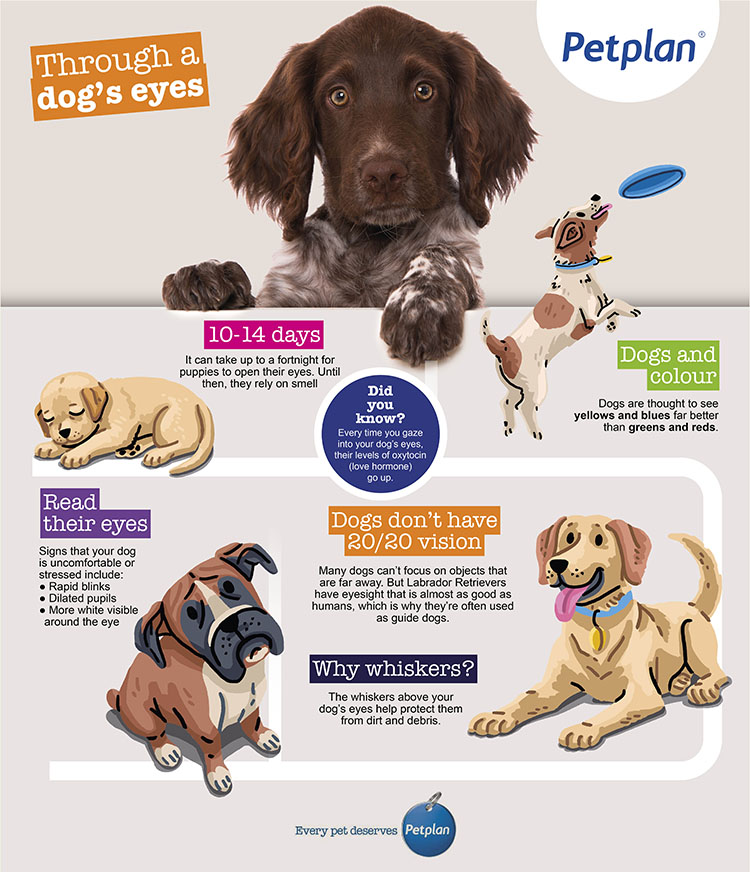Find out how to spot and treat common issues and keep your dog’s vision in tip-top condition with our guide to canine eye health.
From inherited conditions to those caused by an underlying illness or seasonal allergies, there are many different eye problems that can affect your dog. They can arise in all breeds and ages of dogs, so it’s important to know what to look out for. We look at how to take the best possible care of your dog’s eyes, and recognise the symptoms of some common eye conditions. And don’t miss our fascinating fact sheet on dogs’ eyes.
How to care for your dog’s eyes
In between your dog’s regular vet visits, it’s a good idea to give them a quick health check once a week. This can help you spot the early signs of any health conditions, including eye problems. Your dog’s eyes should be clear and bright. Signs that could indicate your dog is developing a problem include:
- Excessive tears or discharge
- Redness
- Squinting or closed eyes
- Cloudiness over any part of the eye
- Rubbing or pawing at the eyes
If any of these symptoms are persistent or appear to be getting worse, ask your vet for advice as soon as possible.
Over time, your dog’s vision can naturally start to diminish. If you notice your elderly dog starting to bump into things or seem less confident negotiating hazards in low-light conditions, you may want to book a consultation with your dog’s vet.
Does your dog have weepy eyes?
Runny eyes in dogs can be due to many different things. Take a closer look at the colour of the discharge. If it’s clear or a light brown, this is from normal tear production and usually not a sign of anything serious. If it’s yellow, then this could be a bacterial infection, which will need attention from your vet. Many dogs do seem to have an increase in tear production during spring, which can be due to pollen allergies or dust. During this time, you may want to clean your dog’s eyes more regularly.
How to clean a dog’s eyes
Dip a cotton wool ball in some cooled boiled water, then squeeze it out so it’s just damp. Starting from the inside of your dog’s eye, wipe the ball across your dog’s closed eyelid. This will loosen any debris and clean away any discharge. You may need to wipe each eye more than once, and you should always use a new piece of cotton wool for each eye.
Most dogs are happy to stand still while you clean their eyes, but if your dog is a bit wriggly, it’s far easier to do this if another person helps to hold them still. Give your dog lots of praise and treats as you clean their eyes, and they’ll soon get used to it.

Common dog eye problems
We’ve rounded up some of the most common eye conditions seen in dogs. If you spot any of the symptoms outlined below, speak to your vet as soon as possible.
Cataracts
Cataracts occur when the lens that sits behind the iris starts to become cloudy. They can be genetic or the result of injury, hypertension or inflammation. A common reason for dogs to develop cataracts is diabetes, which can affect certain breeds more than others. German Shepherds, Labradors and Yorkshire Terriers are all predisposed to diabetes.
Symptoms
- Pupil appears a blue-grey colour
- Signs of reduced vision including reluctance to explore new surroundings, or bumping into objects
- Increased water intake and more frequent urination can be symptoms of diabetes, which can lead to cataracts
Treatment
Without treatment, cataracts can cause vision impairment and eventually blindness. Your vet will discuss whether to offer surgery, which will remove the affected lens. While cataracts are painless, they can reduce your dog’s quality of life, especially if both eyes are affected. Removing the lens does reduce your dog’s ability to focus, but will improve their overall vision.
Conjunctivitis
Also known as pink eye, conjunctivitis creates inflammation of the membranes covering the eye. It’s a common eye problem in dogs and can be caused by a wide range of factors including bacteria, allergies, foreign bodies or a lack of tear production. Another possible cause of conjunctivitis in dogs is entropion. This is an inherited condition in which a dog’s eyelid folds inwards, causing intense irritation.
Symptoms
- Redness
- Discharge
- Swelling
- Pawing at the eyes
- Squinting
Treatment
This will depend on what’s causing the conjunctivitis. Your vet may prescribe topical antibiotic eye drops or anti-inflammatories. Eye washes and artificial tears can also help relieve some symptoms. If entropion is the cause, your vet may recommend surgery to reposition your dog’s eyelid.
Corneal ulcers
Dogs can often end up getting something in their eye, which can graze the cornea and cause an ulcer. Corneal ulcers are more common in breeds with bulging eyes like Cavalier King Charles Spaniels and Pugs, simply because their eyes are more exposed. They can also occur secondary to other conditions such as a lack of tear production (dry eye).
Symptoms
- A visible scratch (but not always)
- Redness
- Watery eyes
- Signs of pain
- Squinting
Treatment
Your vet will use a special dye to detect the size and depth of an eye ulcer. Early treatment of corneal ulcers is vital to avoid both pain and additional damage to the eye. Antibiotics and anti-inflammatories may be used. Surgical debridement can also aid the healing process in some cases.
Third eyelid prolapse (cherry eye)
Your dog’s third eyelid sits in the inside corner of their eye and is usually hidden. It contains a gland that produces tears, keeping your dog’s eyes moist and comfortable. Sometimes the gland prolapses – popping out and causing a swelling in the corner of your dog’s eye. This condition is more common in flat-faced breeds including Bulldogs.
Symptoms
- Pink mass in the inside of the eye
- Redness
- Irritation
Treatment
For mild cases of third eyelid prolapse, eye drops designed to increase lubrication can help. For more serious cases, surgery is often required to place the gland back into a normal position.
Glaucoma
This condition is caused by an increase of pressure within the eyeball. It can arise from a blockage within the ducts that drain excess fluid from the eye. Left untreated, glaucoma can damage the retina and optic nerve. Glaucoma is more common in some dog breeds, including Poodles, Huskies and Pugs.
Symptoms
- Squinting
- Excessive blinking
- Overly large or small pupils
- Pupils unresponsive to light changes
- Redness and/or a blue haze
- Sticky eyes
- Eyeball looks larger than normal
Treatment
Sometimes medication can help reduce the pressure inside the eye, but surgery to remove the lens may also be offered. Your vet will usually refer your pet to a specialist ophthalmologist. In serious cases, removal of the eye may be necessary.
Progressive retinal atrophy (PRA)
This inherited condition causes a dog’s retina, the part of the eye that receives light, to disintegrate. The first signs of this condition include lack of vision at night-time, which then progresses to a complete loss of vision. Certain breeds are predisposed to this condition, including Cockapoos, Labradors and Huskies.
Symptoms
- Night-time blindness
- Decreased response to light changes
- Bumping into things
- Dilated pupils
Treatment
There is no cure for PRA, but most dogs gradually adapt to this condition, which doesn’t cause them any pain.
Paying attention to your dog’s eye health is all part of being a responsible dog owner. If you’re ever concerned about your dog’s eyes, or spot any of the symptoms we’ve outlined above, it’s always best to seek the support of your vet.
How long does it take for a puppy to open their eyes? Download and share our fun fact sheet on dog vision with all your dog-loving friends.

Do you think we’re doing a good job? If you do, please vote for us in this year’s Insurance Choice Awards. Plus, you’ll also be entered into a prize draw to win £1,000 (Ts&Cs apply)
